Have you ever considered the things you’d miss most in a TEOTWAWKI situation? I think a nice hot shower has to be pretty high on my list. It is right up there with coffee. So, once I got my nearly-off-grid little cabin built, I set out to build a prototype rocket water heater.
There are a hundred and one different ways to make a rocket water heater (RWH). But as an introduction, I’ll show you how I built mine. I’ll also mention a few things that I wish I had done differently, just to give you some ideas on how you might construct your own. This is one of those projects that gets better the longer you let it ruminate in your mind.
The beauty of a RWH is that not only can you heat a lot of water with just a small amount of firewood, but for many of us, the fuel is free and abundant and will be available long after the grid goes down. When you think of how hot a campfire is, and then think about how much hotter that same fire gets when you blow on it, that same principle is what makes a rocket stove so efficient. By creating its own constant draft, that higher temperature in my RWH will raise the water temperature 25°F in one pass through the heat exchanger. That’s pretty phenomenal.
System Description
Here’s a quick description of how my RWH works: A small pump (12-v, 3 GPM) takes water out of my regular water heater tank, circulates it through a coil of copper tubing which is located inside the chimney of a rocket stove, then returns the heated water back to the water heater tank. Inline thermometers allow me to monitor water temps so I know when to stop adding fuel to the rocket stove. A simple set of valves near my water heater tank lets me heat water with electricity, or turn the valves to either heat water using the rocket stove or my solar water heater.
The Heart of the System: The Copper Coil
The main component of a RWH is a coil of copper tubing. You’ll need a 25-foot coil of type L, ⅜” copper tubing. (Type K has slightly thicker walls, 0.049″ vs. 0.035″, but I have no experience coiling it so can’t speak for it one way or the other.) If you use less than 25’ it will not heat the water as efficiently since it will exit the rocket stove sooner. But that may not necessarily be a detractor in your particular system design.
When you buy the copper tubing, it will come in a coil about 16” in diameter and you’ll need to reduce the coil down to about 4-5” in diameter. It’s very important to do this without producing any kinks. I only know of two ways to accomplish that. Option 1 involves filling the tubing with sand, which I have no experience with so I won’t discuss it. Option 2 is much simpler and involves filling the coil with water and then freezing it.
When you get the coil home from the hardware store, stand it on end and make sure the two open ends are slightly higher than the rest of the coil. Next, tie a rope or strap around the coil at the 12 o’clock position so you can hang it up after you get it full of water, keeping the two ends as the high points. Now, submerge the coil into a rain barrel, washtub, or whatever you have handy so that you can fill the entire coil with water. It’s very important that no air bubbles remain trapped inside. So you’ll need to suck on one end, or force water through it with a hose nozzle to be sure there are no air bubbles anywhere inside the coil. Once you are certain it is air-free and completely full of water, replace the slip-fit plastic end caps and carefully lift it up, making sure the open ends are at the highest point so that no water is running out, and hang it somewhere so it can freeze. I hung mine on the outside of my shop one cold night. If you have a chest freezer where you can stand the coil upright, that works too.
JWR Adds: If using the freezing method, do not tightly cap the pipe. Only use slip-fit plastic caps. If you don’t allow room for expansion, then the copper pipe will split! Alternatively, if you are doing this project in warm weather, you can completely fill a copper pipe with water and tightly cap the ends by tightly crimping a flattened folded end in a vise. Because fluids are incompressible, this provides nearly the same support as frozen water. You’ll just have to manipulate the pipe more carefully, to avoid kinks.
You’ll know you got a good freeze when you can see ice flowing out the ends, as shown below.
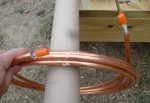 Next, to form the smaller coil which is going to fit inside the chimney of your rocket stove, you’ll need some clamps and a piece of 3” pipe as shown below. Gloves will help since this is frozen tubing we’re working with and you don’t want your warm hands thawing it out. The ice inside is what is going to keep the tubing from crimping or knking, so don’t do this if the day is warming up and the ice is melting. Clamp one end of the tubing, leaving the first 12” straight, and then begin slowly working the ice-filled tubing into a smaller, fairly tight coil. Leave enough space (¼”) so the individual coils aren’t touching each other.
Next, to form the smaller coil which is going to fit inside the chimney of your rocket stove, you’ll need some clamps and a piece of 3” pipe as shown below. Gloves will help since this is frozen tubing we’re working with and you don’t want your warm hands thawing it out. The ice inside is what is going to keep the tubing from crimping or knking, so don’t do this if the day is warming up and the ice is melting. Clamp one end of the tubing, leaving the first 12” straight, and then begin slowly working the ice-filled tubing into a smaller, fairly tight coil. Leave enough space (¼”) so the individual coils aren’t touching each other.
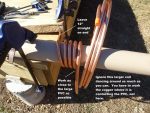 Your hands are only bending the piece of tubing that is in contact with the 3” PVC while the larger coil of copper is going to be dancing around, doing its own thing. But don’t worry about that bigger coil. Just keep your hands working very close to the PVC pipe or you’ll end up with kinks. (Note; Schedule 40, 4” PVC is 4½” in diameter, which would make a copper coil a little over 5½” in diameter. That would still fit inside a 6” chimney pipe but would also result in a shorter coil. I went with 3” to have a taller coil inside the chimney and also to be sure my coil would be surrounded by hot air and not be up against the edge of the chimney pipe. If money grew on trees then I would have tried it both ways — just to be able to quantify the differences in a working RWH.)
Your hands are only bending the piece of tubing that is in contact with the 3” PVC while the larger coil of copper is going to be dancing around, doing its own thing. But don’t worry about that bigger coil. Just keep your hands working very close to the PVC pipe or you’ll end up with kinks. (Note; Schedule 40, 4” PVC is 4½” in diameter, which would make a copper coil a little over 5½” in diameter. That would still fit inside a 6” chimney pipe but would also result in a shorter coil. I went with 3” to have a taller coil inside the chimney and also to be sure my coil would be surrounded by hot air and not be up against the edge of the chimney pipe. If money grew on trees then I would have tried it both ways — just to be able to quantify the differences in a working RWH.)
As you are finishing the smaller coil, you’ll want to leave 12” of straight tubing at the end just as you did at the beginning. I failed to do this and even though it hasn’t caused me any problems I recommend you leave those straight ends. The reason for the extra length is just to keep any soldered fittings 12″ away from direct contact heat of the rocket stove. More about this later.
The last important thing to keep in mind as you finish making the copper coil is the final orientation of each end. Since you drew your plans up ahead of time, you know where to have the two ends of your coil end up in relation to each other. Mine (see photo below) ended up on the same side of the chimney, but then pointing opposite directions to facilitate how they would connect into the outbuilding where my Chlorinated Polyvinyl Chloride (CPVC) hookup was. Using a tee, I was able to get the inlet and the outlet plumbing headed in the same direction as my design required. Also, make sure your two finished ends will fit through your drilled holes in the section of chimney pipe mentioned below. Plan ahead, as it’s a lot less expensive and less frustrating that way.
Other Plumbing Needed
Once your coil is complete, you’ll need some basic plumbing skills to get the rest of the project finished. If you’ve never soldered copper plumbing before, it’s amazingly simple and guaranteed to put a smile on your face when you see it happening before your very eyes. I’ve been doing it for almost 30 years and it still makes me smile every time. Try to keep a straight face when other people are watching you though, it makes you look more professional. Do a web search on the phrase “how to solder copper pipes”. With a little practice, you’ll get the hang of it pretty quickly.
One handy tidbit to know: Type L, ⅜” copper tubing that your coil is made of will just perfectly telescope inside a piece of ½” copper pipe, saving you from buying an adapter fitting or two, while constructing the rest of your heat exchanger.
Your finished coil is going to fit inside of a piece of 24”-long section of uninsulated 6″ diameter metal chimney pipe with a seam. It will look something like this (except that your soldered fittings will be farther away from the actual chimney-mounted heat exchanger because you left that 12” on each end):
The Heat Exchanger
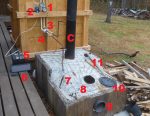
Keep in mind that this type of chimney pipe has a seam and snaps easily apart. You’ll need to disassemble it in order to fit the ends of your copper coil through the two holes you’ve drilled. Once it’s inside the chimney pipe, you’ll solder on whatever other fittings your plan calls for. This is in order to attach your system to your regular CPVC or Pex plumbing lines. As you can see from the accompanying photo, it only takes about two feet of copper before you can safely add a CPVC or Pex adaptor without having to worry about chimney heat melting the plastic pipe. On the left in the photo, the copper fittings are threaded so you can attach threaded unions and begin your CPVC plumbing from there. Using copper-to-CPVC unions will give you a lot of flexibility for any future changes in your RWH configuration. You will also note the copper also ends with a threaded fitting for the drain valve.
Editor’s Note: This annotated photo will also be posted in Part 2 of this article — which will explain the rest of the system in detail.
I have another word of caution: It is best to add drain valves at every low spot in your system. This will save you grief, later. Also, when sweating on 90-degree unions of tees, always leave a couple of inches between unions. That way, if you ever have move or reconfigure anything, you can simply use a tubing cutter to remove pieces, leaving you with ends that can then be re-sleeved in a variety of configurations.
While technically it may be more correct to refer to the copper coil alone as the heat exchanger, I like to refer to this entire unit of chimney pipe, copper coil, and copper fittings as the heat exchanger. With this in your hand as a single unit, you now have a lot of flexibility for making hot water. If you build a system like mine and decide thagt you don’t like it, no problem. You simply remove your heat exchanger and re-install it elsewhere. (I can remove mine in under a minute.) If you are currently renting, then you can hook your heat exchanger up to a portable rocket stove for now and then use it in a permanent system when you buy your own place, later on.
(To be concluded tomorrow. in Part 2.)

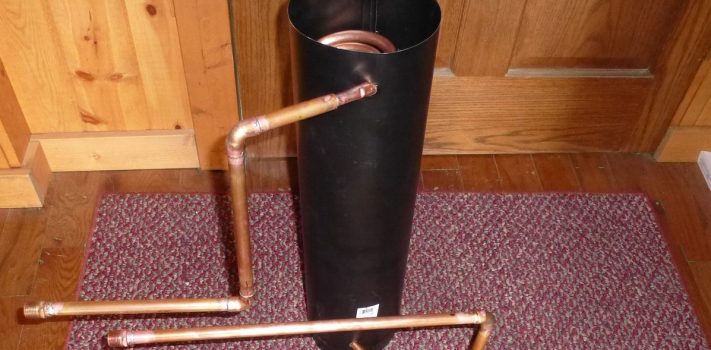









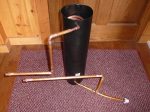
I have yet to install a water heater where heat copper pipe thermo-siphons the hot water, because I do not have enough height and room easily at hand, making it inconvenient. With this less expensive alternative, one can install a roll of copper pipe /tubing above the wood stove. Simply leave the copper in a coil and place it over head, horizontally so the tubing is equally, and heated quicker. The water will become very hot, and deliver several gallons of extremely hot water, perhaps dangerously hot. The is a quick and easy way, a simple way, that also removes the need for a larger storage tank. The hardest part for some one with no experience working with copper is attaching the ends. If that is the case, when purchased, have the plumbing store attach 1/2” pipe threads, compression type fittings, or soldered. When at home, simply install the over the stove by running the copper ends many feet away from the heat source, so that the pex piping, PVC, or other plastic lines will not melt.
This is quick, cheap, and easy, however, instead of 20 or 50 gallons, it produces only a few gallons of scalding hot water, yet mixed with cold water, it is enough for a shower, or about 6 gallons, warm enough for doing the dishes. I could increase the amount of water simply by adding more copper tubing, or a small metal reservoir, and might one day. Adding tubing would be easier, and reheating the water at a faster rate than if a reservoir was used. The line is pressurized by a 12vdc Shurflo RV pump that has a pressure switch that shuts of the pump with the facet is turn off. The same pump can pressurize several lines, or one that is hot and one that is cold. Using separate facets, or a standard sink facet.
I also have an antique wood cook stove with a water jacket that is also the fire box. It has standard 3/4” pipe fittings, and would make an excellent water heater. I traded $50.00 worth of work for it, and it is in beautiful condition. No one else wanted it.
There is a replica for sale for about $500.00, and then there a modern stoves with jackets. A quick and easy search will find you some thing.
https://www.usewood.net/wooden/topic/wood-stove-with-water-jacket
There are other ways to make hot water that does not involve a hot stove, but propane burners to heat a reservoir or metal tank that gravity feeds a plumbing system. It is simple to make, inexpensive and reliable, good for the summer, but that one takes some plumbing skills. Or just heat it up on the stove and pour it into bath tube just like the old days. Very hot water is very dangerous, I’ve got burns to prove it. But a little amount, a few gallons of very hot water will heat up a many times the amount of cold water, enough for a shallow bath that would allow one to soak in.
Hey Tunnel Rabbit, lots of good points.
For anyone who already has a propane blowtorch, it’s worth playing around with some copper fittings just to see how easy it it to learn to solder copper pipe.
As Tunnel Rabbit pointed out, there are some disadvantages to thermo-siphon systems. One is that they can produce dangerously hot water and they can also vapor lock. As I will point out in part 2 tomorrow, using a 12v water pump to circulate the water gives you much more flexibility and safety. You can heat any quantity of water to the exact temperature you want whether you’re using a rocket water heater, a coil of copper above your stove as Tunnel Rabbit describes, or any other variation. Most of these pumps are rated to last 30,000+ hours so they are a very cheap investment for the amount of efficiency and safety they will add to any system.
Thank you for the comment. Hot water is very important for sanitation and comfort. I can be comfortable with a smaller system, whereas many persons, or a family would require large quantities of hot water. A large coil of copper tubing sitting behind a wood stove would perhaps be the easiest solution, but excessive heat, and vapor lock could be an issue. Tubing that is positioned to be horizontal to the ground, is less likely to have an issue with vapor lock, and the very high temperatures that can boil water and produce vapor lock, can be regulated by moving the coil further away from the heat source. Another way is to use hard pipe and 90 degree ‘street’ elbows and standard elbows, to make sharp bends to make an heat exchanger in place of the tubing. The tubing is easier if you can get it.
After years of use, I’ve never had an issue. Mine is shaped to fit on a metal shelf that is only 12 inches wide. Not pretty, but I prefer practical, and some hot water rather than none. My stove pipe exits the structure through the wall, making this hot water generator of sorts, possible. I forgot that most stove pipes exit the roof. However, something this simple might still work. I can think of a number of ways to create other simple hot water heaters for wood stoves, but that would be a long and boring article. So I’ll be very brief and let the reader figure out the details. I have built and used this in the past. Use a metal container and feed it with water that controlled with a float valve. I have an all copper and brass one outside. It will not melt. The old fashion toilet valve kind works. Get the brass float if you can. The tank is not pressurized, but feeds the outlet using gravity, or a 12vdc Shurflo pump that has a pressure switch, that provides water to the outlets. This is safe and relatively easy to build. Use a tight fitting lid to over prevent contamination of the tank, and to prevent excessive humidity from building up in the house.
Sweating copper is easy once one has done it a few times. It is however a skill and can be difficult if good technique is not followed each time. I make antennas with the stuff, and have done much plumbing with copper and all other types of pipe. When sweating larger fittings, multiple fittings, facet connections, working in tight spaces, or when water is in the line, that is when skill and experience is needed most. But when sweating a new fitting onto a new clean pipe, watch a video or two, and you too can do this with confidence. It is a skill worth having.
Tunnel Rabbit, as you are demonstrating, there are definitely a lot of ways to heat water if we think out of the box. My original design was simple with lots of hot water: the coil was going to go on the outside of the single-walled chimney pipe coming out of the top of my wood stove. With a 12-v, 1.2 GPM pump and a tank (such as you describe) in the loft I’d have hot water six months of the year just as a bonus from heating my house. I later changed my mind when I decided to keep all plumbing pipes on the perimeter where they can’t cause much damage if they leak.
If anyone does adopt an system using copper coil on the outside of the stove pipe, you have to be sure to clean the chimney more frequently. The water cools the flue gasses down and causes a quicker buildup of creosote which is a fire hazard.
Clever. I see a lot of applications, especially in the warmer months when no one wants to deal with a lot of heat unnecessary heat.
St. Funogas is the engineer I wish I was!
Interesting article…One word of caution….get “fresh” copper tubing (relatively recent production) the older it gets the more brittle it becomes and harder to “work” (bend) without kinking. I am a retired master plumber…had a customer try to run a 1/4″ copper line for an icemaker,…had about a jillion kinks in it…called me,… i came out and ran the line with no trouble whatsoever…he was impressed with my skill…what I never told him was that the tubing he bought at walmart was so old and on the shelf for so long that no one could bend it without kinks and mine was from the plumbing supply house and was relative new and very easy to “work”.
Texas Prepper, thanks for that excellent tip. Is it safe to assume that the shiny tubing is probably the newest?
ST. Funogas…copper does oxidize as it ages…so that would probably be a good measure…I would get mine from someone who sells a lot of copper tubing…..like a plumbing supply…probably not some small hardware store with maybe old stock….However what we are talking about would be copper with maybe several years shelf life on it….As a side note copper is sometimes called by its ID (inside diameter) and some times by its OD (outside diameter)…so it can be confusing if you don’t know the jargon.
ya dont have to be an engineer to do this stuff BUT YOU DO HAVE TO COPY SAME AND MAKE IT!
Amen John. The only difficult part, really, is learning to solder copper pipe, and it’s not that difficult. As Tunnel Rabbit pointed out, this is the easy stuff: new pipe, new fittings, no water in them.
If you wish to make a similar unit during the middle of the summer, and don’t have a way to freeze the water, sand works great. Real fine white masonry works best but you can just common ‘play sand’. If you are a real trooper you can even sift your own. Use a standard window screen.
Get yourself a small funnel and an assistant helps. Put some of the sand in a flexible plastic bag, just a shopping bag or a small trash bag. This makes pouring the sand into the funnel easier, much better than trying to keep dipping small amounts with a cup.
Plug one end, place your funnel in the other end and start pouring the sand through the funnel. Here is where that assistant comes in handy. You need to make sure to fill the pipe completely. Have your assistant slowly rotate the pipe as you pour in the sand. With one person you just have to, pour/turn, pour/turn.
I really think the sand method is better. Sand actually has a little more give than ice because the individual grains of sand have a tendency move against one another and there is no worry about the ice melting on you as you work.
When you are done with your bending just make sure you rinse out your tubing well.
Isn’t there risk of the water getting superheated, forming a bubble and exploding? I love the simplicity of this design, but I’ve heard people smarter than me saying not to put copper tubing that close to the flame of a rocket stove/heater because of risk of flash expansion.
Hi Monkey Wrangler, the circulation pump is specifically for that purpose. It keeps the water flowing so it is gradually heating up as it circulates, not allowing steam to form. Part 2 will explain the need for a pressure relief valve in the system in case something goes amiss and steam does form.
It may not be a bad idea to have a second relief valve in there somewhere in case the first fails. It is a low probability event, but if it does happen, the consequences could be severe.
Hey Monkey Wrangler, now that you bring it up, for under $15 you could put a relief valve in on either side of the heat exchanger instead of just the one. If they were two different brands, that would really build in an element of safety. Nothing worse than a steam explosion after the grid goes down and they’re picking copper tubing and CPVC out of you with sharpened chopsticks. 🙂 That $15 sounds like pretty cheap insurance to me.
Thanks for article, looking forward to the next installment. The pictures are a huge help. The older I get, the more pic I need to learn.
I didn’t see one or read of one in the system, but it might be prudent to put a relief valve in the line somewhere. Maybe you are relying on the one in the hot water tank you are feeding. Personally, I would want something in line as well, just in case a valve gets closed or a line gets blocked. Just a thought.
Hi Benjammin, in the bottom photo, item #3 is the pressure relief valve, to be discussed in part 2. You are correct, a pressure relief valve is a must, and as close to the heat exchanger as possible.
Here in the south we call that a worm, it’s part of a moonshine still. It’s still an absolutely genius idea though. It’s beauty is in its simplicity.
Good stuff
Tubing bender.
For some reason when reading the article all I can hear was an Irish brogue in my head 🙂
Like the old Boston Irish.
Anyways good stuff ! Done allot of traveling and no matter where i end up as long as there’s a hot shower and a cup of coffee in the morning I’m good.
In times of trouble a hot shower will be a great luxury indeed . Looking forward to part 2
I have such a heater unit. It was build in the 1900’s to the ’30’s. I found it in an apartment building I used to own. I kept it because it looked unused and in new condition. It consists of a copper coil, inside an ornate cast iron housing. Between the housing and the coil used to be an asbestos tube (it disintegrated over the years). It was fired by a natural gas burner. The antique value is only a couple of hundred dollars so I can see where this could be put to use as the basis for your rocket stove water heater, just heating with wood instead of gas.